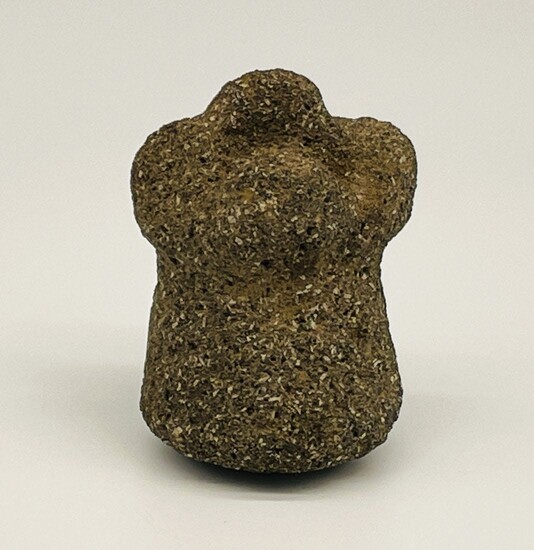Pre-Columbian Melee Weapon Mace Head
Pre-Columbian Melee Club Weapon Mace Head. This circular star-like stone club head features four evenly space nub or spike-like elements on the upper sides of the head, with a fifth pointing out on the head's end | Approx. 3.25" H x 2.5" W | Provenance: Estate of Dr. Ora & Eleanor Eads, Nashville, TN | The proper cultural attribution of stone mace heads of this type is unclear. Carved stone mace heads were made as early as the middle of the first millennium B.C. in the Central Andes, by artisans of the Chavín and Cupisnique cultures. A sculpted mace head was excavated from a burial at Kuntur Wasi in the northern highlands of Peru (Fux, 2013:310, cat. no. 105). Objects stylistically similar to the present mace head have been excavated from burials of the Salinar culture, which dominated Peru’s northern coastal region from 200 B.C.–A.D. 100 (Burger, 1998; Strong and Evans, 1952:55–56, pl. IIIE). References: Strong, William Duncan, and Clifford Evans Jr. Cultural Stratigraphy in the Virú Valley Northern Peru. The Formative and Florescent Epochs. New York: Columbia University Press, 1952;Lapiner, Alan C. Pre-Columbian Art of South America. New York: H. N. Abrams, 1976, p. 68, pl. 134;Burger, Richard L. "Mace Head." In Andean Art at Dumbarton Oaks, edited by Elizabeth Hill Boone. Vol. vol. 1. Washington, DC: Dumbarton Oaks Research Library and Collection, 1996, pp. 84–86, pl. 9; andFux, Peter, ed. Chavín: Peru's Enigmatic Temple in the Andes. Zurich: Museum Rietberg, 2013.
[ translate ]View it on
Estimate
Reserve
Time, Location
Auction House
Pre-Columbian Melee Club Weapon Mace Head. This circular star-like stone club head features four evenly space nub or spike-like elements on the upper sides of the head, with a fifth pointing out on the head's end | Approx. 3.25" H x 2.5" W | Provenance: Estate of Dr. Ora & Eleanor Eads, Nashville, TN | The proper cultural attribution of stone mace heads of this type is unclear. Carved stone mace heads were made as early as the middle of the first millennium B.C. in the Central Andes, by artisans of the Chavín and Cupisnique cultures. A sculpted mace head was excavated from a burial at Kuntur Wasi in the northern highlands of Peru (Fux, 2013:310, cat. no. 105). Objects stylistically similar to the present mace head have been excavated from burials of the Salinar culture, which dominated Peru’s northern coastal region from 200 B.C.–A.D. 100 (Burger, 1998; Strong and Evans, 1952:55–56, pl. IIIE). References: Strong, William Duncan, and Clifford Evans Jr. Cultural Stratigraphy in the Virú Valley Northern Peru. The Formative and Florescent Epochs. New York: Columbia University Press, 1952;Lapiner, Alan C. Pre-Columbian Art of South America. New York: H. N. Abrams, 1976, p. 68, pl. 134;Burger, Richard L. "Mace Head." In Andean Art at Dumbarton Oaks, edited by Elizabeth Hill Boone. Vol. vol. 1. Washington, DC: Dumbarton Oaks Research Library and Collection, 1996, pp. 84–86, pl. 9; andFux, Peter, ed. Chavín: Peru's Enigmatic Temple in the Andes. Zurich: Museum Rietberg, 2013.
[ translate ]


